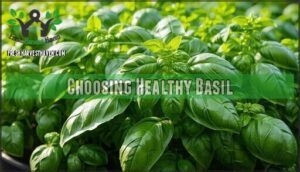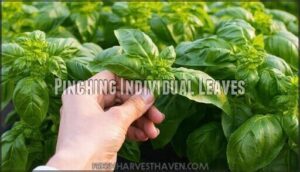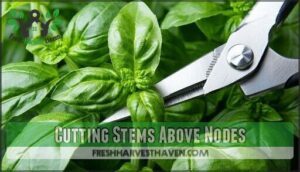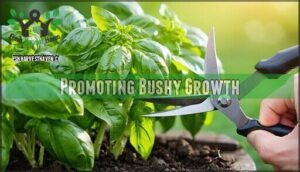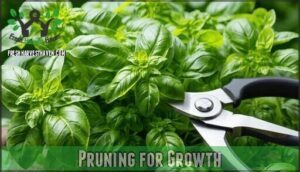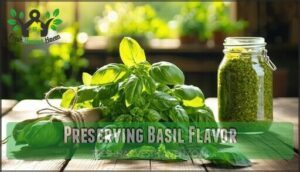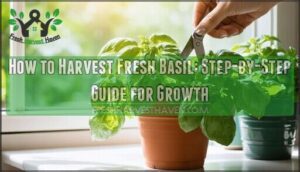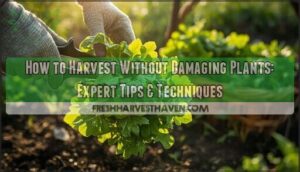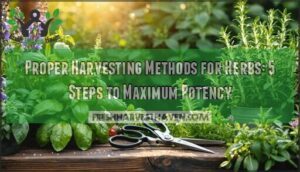This site is supported by our readers. We may earn a commission, at no cost to you, if you purchase through links.
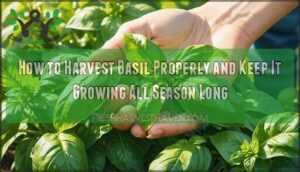
Instead of picking individual leaves, cut stems just above a leaf node where two leaves meet – this encourages bushy growth and doubles your harvest.
Always pinch off flower buds before they bloom to keep leaves tender and flavorful, and choose healthy stems with vibrant green leaves, avoiding any that look wilted or damaged.
Make clean cuts with sharp scissors or pinch with your fingernails to prevent plant stress, as the secret lies in understanding exactly where and when to make those cuts for maximum flavor and continuous growth.
Table Of Contents
- Key Takeaways
- Harvesting Basil Time
- How to Harvest Basil
- Choosing Healthy Basil
- Harvesting Techniques
- Preventing Basil Flowering
- Pruning for Growth
- Storing Harvested Basil
- Preserving Basil Flavor
- Frequently Asked Questions (FAQs)
- How do you harvest basil so that it keeps growing?
- Should basil leaves be picked from the top or bottom of the plant?
- How do you harvest a basil plant?
- How do I take basil?
- Should you harvest basil leaves?
- How often should you harvest Basil?
- Why do you need to harvest Basil?
- Can I harvest more than a third of a basil plant?
- When should you not eat basil leaves?
- How do pests affect basil health and yield?
- Conclusion
Key Takeaways
- Harvest in the morning when essential oils are most concentrated – you’ll get maximum flavor before the sun heats up and evaporates those aromatic compounds
- Cut stems above leaf nodes rather than picking individual leaves – this triggers two new shoots to grow from each cut point and doubles your harvest potential
- Pinch off flower buds immediately to keep leaves tender and prevent the plant from going to seed, which makes leaves bitter and stops new growth
- Never harvest more than one-third of your plant at once to avoid shocking it – regular weekly harvesting keeps your basil producing fresh leaves all season long
Harvesting Basil Time
When you’re ready to harvest your basil, timing matters more than you might think.
The best time to pick those fragrant leaves is in the morning when the plant’s essential oils are at their peak concentration, giving you the most flavorful harvest possible.
Morning Harvest Benefits
Morning brings out basil’s best flavors, making it the ideal harvesting time. Your plants have spent cool overnight hours producing peak oil content and achieving peak flavor retention. The dew provides natural moisture preservation, ensuring the best leaf quality possible.
Cool nights concentrate basil’s essential oils, making morning harvest the flavor jackpot for your kitchen.
Here’s why morning matters:
- Fragrant oils reach maximum concentration after cool nights
- Leaf tissues stay plump and tender from overnight moisture
- Essential compounds haven’t evaporated in heat yet
Smart harvesting basil means timing your harvest right. Those fragrant oils that make your dishes sing are most potent before the sun heats up. Morning harvest captures this natural chemistry, giving you leaves that pack serious flavor punch for your kitchen creations.
Avoiding Afternoon Harvest
Afternoon heat-stress turns basil harvesting into a disappointing experience.
When temperatures climb, your basil’s oil concentration drops dramatically, leaving leaves with weak flavor and tough texture.
The sun basically "cooks" those precious aromatic compounds you’re after.
Meanwhile, moisture retention plummets, causing leaves to shrivel and lose their tender appeal.
This timing mistake ruins ideal aroma and leaf quality that morning harvest delivers effortlessly, resulting in a loss of tender appeal.
Ideal Weather Conditions
Perfect weather conditions make harvesting basil a breeze. You’ll get the most flavorful leaves when Temperature Effects and Sunlight Exposure work together. Humidity Levels and Wind Protection also impact leaf quality during basil harvesting.
Perfect weather turns basil harvesting into pure garden magic—when temperature, sunlight, and humidity align just right.
Here are five essential basil harvesting tips for ideal conditions:
- Choose temperatures between 70-85°F for peak essential oil production
- Pick during warm, dry days with bright sunlight
- Avoid harvesting after Rainfall Impact when leaves bruise easily
- Provide gentle breezes to offer natural Wind Protection
- Schedule harvest before first frost threatens your plants
When to harvest basil depends on these environmental factors working in harmony.
How to Harvest Basil
Proper harvesting technique transforms your basil from a struggling plant into a leafy powerhouse. Start when your plant reaches 6 inches tall with at least four sets of leaves. You’ll want to harvest weekly during peak growing season to encourage continuous growth and prevent flowering.
Use clean scissors or sharp pruners for thicker stems, but you can pinch tender leaves with your fingers. Always cut just above a leaf node—this encourages two new shoots to grow from each cut point. Never harvest more than one-third of the plant at once, as this can shock your basil into survival mode.
Here’s your harvesting roadmap:
- Harvesting frequency: Pick leaves weekly or bi-weekly during summer months
- Tool sterilization: Clean scissors between plants to prevent disease spread
- Leaf quality: Choose young, tender leaves for maximum flavor
- Optimal yield: Regular harvesting boosts production throughout the season
These basil harvesting tips guarantee maximum leaf quality while maintaining plant health all season long.
Choosing Healthy Basil
When selecting basil for harvest, you’ll want to target plants that have reached 6-8 inches in height with at least four sets of mature leaves.
Look for vibrant green foliage without yellowing, brown spots, or wilted areas, as these signs indicate stress or disease that can affect flavor and growth potential.
Plant Height and Leaf Count
Your basil plant reaches optimal height for harvesting when it stands 6-8 inches tall with at least four sets of mature leaves.
This plant maturity signals harvest readiness across different growth stages. Look for abundant leaves that are fully developed rather than counting basil leaves alone.
Plant height matters because shorter plants haven’t developed enough leaf development for sustainable leaf harvesting. You can start leaf plucking once your plant meets both criteria.
Harvesting in the early morning hours maximizes flavor.
Leaf Size and Color
Once your basil hits the right height, check for these signs of happy leaves:
- Plump leaves, 2–4 inches long, signal Leaf Maturity.
- Vibrant, deep green shows Ideal Pigmentation.
- Even Color Variation means abundant leaves got enough sun.
- Skip small or yellow leaves—those lack flavor.
Visual Indicators help you pick the best basil leaves every time.
Avoiding Damaged Plants
A detective’s eye for detail makes all the difference when selecting your basil harvest. Skip plants showing signs of stress or disease, as damaged specimens produce bitter, less flavorful leaves.
Sterilized tools guarantee proper cuts that prevent shock to your basil plant.
- Inspect leaves carefully – Look for yellowing, brown spots, or wilting that signals plant health issues
- Check for pest damage – Small holes or sticky residue indicate insects affecting leaf quality
- Examine healthy roots – Firm, white roots support vigorous growth and better flavor production
- Use gentle handling techniques – Avoid bruising stems during harvesting basil to maintain plant vitality
Harvesting Techniques
When you harvest basil the right way, you help the plant grow back faster and fuller.
You’ll use simple methods like pinching leaves or cutting stems above a node to keep your basil healthy and productive.
Pinching Individual Leaves
Why grab just any leaf when you can select the perfect ones? Leaf Selection matters—choose vibrant, healthy basil leaves for best results.
Use gentle Pinching Technique at the base where leaves meet stems. This proper plucking method maximizes Flavor Retention and triggers Growth Impact by encouraging new shoots.
| Leaf Selection | Pinching Technique | Growth Impact |
|---|---|---|
| Choose vibrant leaves | Pinch at leaf base | Triggers new growth |
| Avoid damaged spots | Use gentle pressure | Promotes bushiness |
| Select mature size | Target leaf nodes | Extends harvest season |
| Pick healthy color | Clean fingernails help | Maintains plant vigor |
Regular Harvesting Frequency keeps plants productive all season.
Cutting Stems Above Nodes
When harvesting basil stems, make your cuts about ¼ inch above a leaf node using sterilized scissors.
This node cutting technique triggers growth stimulation, causing two new shoots to emerge from each cut point.
Sharp, clean tools prevent disease transmission and guarantee healthy regrowth. You can find specialized tools for successful leaf propagation to aid in this process.
Cut at a slight diagonal angle to help water drain, preventing damage from rot. This stem cutting method maximizes your basil harvest.
Promoting Bushy Growth
When aiming for bushy growth, cut your basil’s central stem just above a node.
This technique works like flipping a switch—two new shoots emerge where you made the cut.
Regular pruning keeps your plant compact and productive.
Focus on top removal by trimming the main stem’s tip, which signals side branches to develop.
Node cutting is your secret weapon for harvesting basil while maintaining plant health.
Stem trimming every few weeks guarantees continuous leaf production.
Pinching leaves from growing tips also encourages lateral growth, creating that full, bushy appearance you want.
To guarantee the best flavor, remember to harvest basil in the cool morning hours.
Technique Benefits
Preventing Basil Flowering
When your basil starts producing flower buds, you’ll need to act fast to keep those leaves tender and flavorful.
Regular removal of these buds tricks the plant into focusing its energy on leaf production instead of going to seed.
Removing Flower Buds
Once basil produces flowers, it becomes bitter and stops growing new leaves. Flower bud removal is your secret weapon for flavor preservation and continued growth. Pinch off those tiny buds the moment you spot them – this energy redirection keeps your plant focused on producing tender leaves instead of seeds. Bolting prevention means increased yield all season long.
- Check plants weekly for emerging flower buds
- Pinch buds between your thumb and forefinger
- Cut larger buds with clean scissors
- Remove entire flowering stems if needed
- Focus on blooming prevention for maximum harvest
Regular Harvesting
Regular basil harvesting every 2-3 weeks promotes continuous growth and preventing bolting.
Pick leaves from the top down to maintain plant health and encourage consistent yield.
Harvesting frequently keeps basil leaves tender while pruning basil stimulates new shoots.
This simple how to harvest approach delivers flavor enhancement through younger, more aromatic leaves that’ll make your dishes shine.
Trimming Stem Tops
Cut stem tops just above nodes where leaves meet the stem. This topdown pruning technique using sterilized pruners prevents growth shock while promoting lateral branching for denser foliage.
Weekly harvesting frequency keeps plants producing fresh leaves. Strategic stem trimming redirects energy into new shoots, creating bushier basil harvesting results.
Proper pruning basil timing prevents flowering and maintains vigorous growth throughout the season. Basil should ideally be harvested to maximize flavor and oils in the morning.
Pruning for Growth
Smart pruning turns your basil plant into a leafy powerhouse that keeps producing fresh herbs all season long.
The key is knowing where to cut and when to stop so your plant stays healthy and productive.
Encouraging New Sprouts
Every healthy basil plant needs a little encouragement to sprout new leaves.
Use these steps for smart basil pruning and balanced growth:
- Find a strong stem and spot a node.
- Use sharp scissors for Node Cutting.
- Try Top Pruning for bushier plants.
- Practice Regular Trimming for steady growth.
- Pinch stems above nodes—fresh sprouts will follow!
The provided steps are designed to help achieve balanced growth in basil plants.
Avoiding Over-Pruning
When you’re in the garden with pruning shears, remember that less is more.
Never remove more than one-third of your basil plant at once—this prevents Growth Shock and maintains Plant Health.
Strategic pruning, like thinning cuts, can also promote better growth and improve overall plant vigor.
| Harvesting Limits | Pruning Frequency |
|---|---|
| Maximum 1/3 removal | Every 2-3 weeks |
| Above leaf nodes | Sharp, clean cuts |
| Preserve lower leaves | Monitor plant recovery |
Excessive Leaf Removal stresses your plant’s root system, slowing recovery time.
Cut ¼ inch above nodes for precise basil pruning.
Your plant needs enough foliage for photosynthesis—think of leaves as solar panels powering future growth.
Maintaining Plant Shape
Shaping your basil through strategic pruning techniques creates a healthier, more productive plant.
Focus on stem cutting above node locations to encourage bushier growth. Regular basil trimming prevents legginess and maintains attractive form.
Pruning Techniques for ideal shape:
- Pinching techniques – Remove growing tips when plants reach six inches tall
- Leaf removal – Target older, larger leaves first during harvesting frequency
- Node location targeting – Cut just above leaf pairs for dual branching
- Bushy growth encouragement – Trim center stems more than outer ones
- Rotate pruning spots weekly to maintain even canopy development
Storing Harvested Basil
Once you’ve harvested your fresh basil, proper storage becomes essential to maintain its flavor and extend its usability.
The right storage method depends on whether you plan to use the basil immediately or preserve it for future cooking adventures.
Water Storage Method
Place freshly harvested basil leaves in a glass jar with water at room temperature, avoiding direct sunlight exposure.
This storage method maintains water freshness when you change it every two days.
Your basil storage will keep leaves vibrant for up to seven days.
Choose the right container type – a wide-mouth jar works best for proper storage duration and easy access.
Freezing and Drying Methods
Several freezing techniques and drying methods preserve basil’s flavor for months.
Freezing basil in olive oil using ice cube trays creates convenient portions for cooking. Flash-freezing whole leaves maintains essential oils better than traditional storage methods.
Basil freezing products offer various tools and options for preserving your harvest.
Choose your preferred herb preservation method:
- Oil infusion cubes: Blend basil with olive oil, freeze in trays
- Flash-freeze whole leaves: Spread on baking sheets, then bag
- Air-dry bundles: Hang upside down in cool, ventilated areas
- Dehydrator drying: Low heat for 12-24 hours preserves oils
- Airtight containers: Store dried basil away from light
These long-term storage solutions maintain flavor retention for up to six months when done properly.
Avoiding Refrigeration
Unlike tropical plants that thrive in warmth, fresh basil wilts when refrigerated. Cold temperatures below 50°F cause browning prevention issues, turning leaves dark within days.
Instead, use water storage at room temperature for best preservation. Place stems in water like cut flowers, avoiding the fridge entirely.
For longer storage, consider freezing options or drying alternatives to maintain flavor.
| Storage Method | Duration | Quality Result |
|---|---|---|
| Room Temperature | 7-10 days | Fresh, vibrant |
| Refrigeration | 2-3 days | Brown, wilted |
| Freezing | 6 months | Flavor preserved |
| Drying | 1 year | Concentrated taste |
Preserving Basil Flavor
Once you’ve harvested your basil, you’ll want to use it quickly to capture that peak flavor and aroma.
Fresh basil works best in dishes like caprese salad, pasta, or pizza, while making pesto or freezing leaves in olive oil helps preserve that garden-fresh taste for months, utilizing the basil in various ways.
Using Fresh Basil
Now that you’ve stored your fresh basil properly, it’s time to put those vibrant leaves to work. Fresh basil packs the most punch when you use it right after harvesting basil – those essential oils are at their peak!
- Basil pairings: Combine fresh basil with tomatoes, mozzarella, and olive oil for classic caprese
- Culinary applications: Toss whole basil leaves into pasta dishes or pizza just before serving
- Garnish ideas: Top soups, salads, and grain bowls with torn basil leaves for instant freshness
Fresh basil recipes shine when you add leaves at the end of cooking. Heat destroys those delicate oils, so save the basil uses for final touches. Basil infusions work great in cold dishes too – muddle leaves gently in dressings or cocktails.
Making Pesto and Other Preserves
Pesto’s magic lies in suspending basil leaves in oil, which research shows retains up to 90% of aromatic compounds when frozen.
Create pesto variations without garlic for longer storage, or try basil vinegar for salads and infused oils for dressings.
Basil salt from drying methods adds year-round flavor. Compound butters and herb-infused oils capture volatile compounds effectively.
You can even find products to assist with a great basil pesto recipe.
These preserving basil techniques maintain flavor far better than standard freezing alone, giving you delicious basil recipes and reliable storage options throughout winter months.
Adding to Various Dishes
Fresh basil leaves work magic in countless dishes. Add them to pasta, salads, and soups for instant flavor enhancement. Toss chopped basil into hot dishes at the end of cooking to preserve those precious essential oils.
Transform your meals with these basil pairings:
- Italian cuisine classics – Fresh basil leaves elevate margherita pizza and caprese salads
- Flavor profiles – Combine with tomatoes, garlic, and olive oil for authentic taste
- Garnish options – Whole leaves make stunning recipe ideas for any dish presentation
Frequently Asked Questions (FAQs)
How do you harvest basil so that it keeps growing?
Ever wonder if snipping basil helps it grow?
It’s true! Pinch leaves just above a leaf node, never more than a third at once.
This tells your plant, “Hey, make two new branches!”—and it does.
Should basil leaves be picked from the top or bottom of the plant?
Always pick basil leaves from the top of the plant. This technique encourages bushier growth and prevents the plant from becoming tall and lanky, ensuring continued leaf production.
How do you harvest a basil plant?
Harvesting triggers up to 200% more leaf growth when done correctly. Cut stems just above leaf nodes using clean scissors, taking no more than one-third of the plant’s height at once.
How do I take basil?
Pick leaves individually from the base where they meet the stem, or cut entire stems just above a leaf node using scissors.
Harvest from the top down, taking no more than one-third of the plant at once to encourage continued growth.
Should you harvest basil leaves?
Most people think basil’s too delicate to harvest regularly, but you should absolutely harvest those leaves! Regular picking keeps your plant producing fresh, flavorful leaves all season long.
How often should you harvest Basil?
You should harvest basil every two to three weeks during the growing season. Regular harvesting encourages bushier growth and prevents flowering, which keeps leaves tender and flavorful throughout summer.
Why do you need to harvest Basil?
Regular removal revitalizes your basil by preventing flowering, which stops leaf production and makes leaves bitter.
You’ll encourage bushier growth, extend the harvest season, and maintain peak flavor by continuously picking leaves before the plant bolts, which is a key step in maintaining peak flavor.
Can I harvest more than a third of a basil plant?
You shouldn’t harvest more than one-third of your basil plant at once.
Cutting beyond this limit can shock the plant and stunt its growth, preventing it from producing new leaves efficiently, which is a complete concept to consider for the health of your plant.
When should you not eat basil leaves?
Don’t eat basil leaves that are yellowing, wilted, or damaged. Also avoid leaves after the plant has flowered, as they’ll taste bitter and sharp instead of sweet and aromatic.
How do pests affect basil health and yield?
Aphids, spider mites, and thrips drain nutrients from your basil plants, causing yellowing leaves and stunted growth.
These pests reduce essential oil production, weakening flavor and substantially decreasing your harvest yield potential.
Conclusion
Studies show that regular harvesting can increase basil yields by up to 400% compared to leaving plants untouched.
Now you’re equipped with the knowledge to harvest basil properly and maximize your garden’s potential.
Remember to cut stems above leaf nodes in the morning when essential oils peak, pinch flower buds consistently, and store your harvest correctly.
With these techniques, you’ll enjoy fresh basil all season while encouraging continuous, bushy growth that keeps giving.

